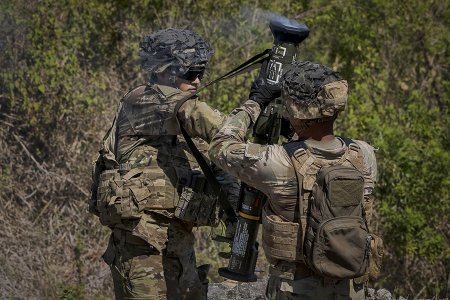"Though we have acheived progress, our work is not over. That is why I support the mission of the Arms Control Association. It is, quite simply, the most effective and important organization working in the field today."
U.S. Sends Once-Barred Missiles to Philippines Exercise
May 2024
By Xiaodon Liang
For the first time, the United States deployed to a foreign country ground-launched missiles previously barred by the now-defunct Intermediate-Range Nuclear Forces (INF) Treaty. A U.S. Army task force equipped with the new Mid-Range Capability (MRC) missile system participated in the two-week Salaknib 2024 military exercise in the northern Philippines in mid-April.

The MRC system, called the Typhon, launches the Tomahawk cruise missile and the Standard Missile-6 (SM-6) multipurpose interceptor. (See ACT, January/February 2021.) Each battery is equipped with mobile missile launchers, an operations center, and additional support vehicles. The Army has activated two MRC batteries and intends to field a total of five such systems. The current deployment in the Philippines is a temporary one and will last only for the duration of the exercise.
The inclusion of an MRC battery in the annual U.S.-Philippine exercise signals U.S. intentions and ability to deploy long-range missiles to the first chain of islands off mainline China in the event of a conflict. From the northern Philippines, the MRC capability could contribute to anti-ship missions in the South China Sea and the Taiwan Strait, as well as attacks against fixed Chinese targets.
The battery deployed for Salaknib 2024 was airlifted from Joint Base Lewis-McChord in Washington state, but the Army previously has said that the Typhon would be deployed outside of the continental United States, Breaking Defense reported in December. Such comments have contributed to predictions that the MRC capability will be located in Guam, a U.S. territory, during peacetime. The Army has not confirmed this basing plan.
The U.S. military first deployed sea- and air-launched variants of the Tomahawk missile in the 1980s. With an estimated range of more than 1,600 kilometers, a ground-launched variant of the modern Tomahawk cruise missile would have been prohibited under the INF Treaty. That treaty barred the Soviet Union, the Soviet successor states, and the United States from producing, testing, and deploying ground-launched missiles with a range of 500-5,000 kilometers. It also required the United States to destroy an older ground-launched nuclear-armed variant of the Tomahawk, the BGM-109G cruise missile.
According to the president’s fiscal year 2025 budget proposal, the Army will purchase more than 330 of the newest Block V variant of the Tomahawk cruise missile for its MRC batteries over the next five years. The Navy concurrently is implementing incremental upgrades to the Block V Tomahawk to improve its anti-ship capabilities.
In 2016, the Navy announced it would modify the SM-6 missile, originally designed as an anti-aircraft and missile interceptor with a range of up to 370 kilometers, to provide it with an anti-ship capability. The decision to modify the SM-6 came in the context of concerns that Chinese anti-ship and land-attack missiles had significantly longer ranges than U.S. options.
The U.S. military could soon deploy in Asia other ground-launched missiles with capabilities that would have placed them under the INF Treaty. The Marines already have integrated launchers for the Tomahawk missile with two types of ground vehicles. In addition, the Army received in December the first deliveries of the Precision Strike Missile, a surface-to-surface missile that is compatible with existing mobile ground launchers. An October 2021 test of this missile established a maximum range beyond the design target of 499 kilometers, and the Army has awarded two early-stage contracts to develop an advanced variant of the missile with a 1,000-kilometer range. In January, the Army announced that it had tested an anti-ship seeker for the missile.
The United States withdrew from the INF Treaty in August 2019 citing Russian development of the 9M729 ground-launched cruise missile, leading Moscow to suspend its treaty obligations.
Russian Deputy Foreign Minister Sergei Ryabkov told Kommersant on April 11 that Russia would withdraw its offer of a moratorium on the deployment of missiles with ranges falling under INF Treaty specifications, first floated by President Vladimir Putin in 2019, if the United States stationed the missiles in Europe and Asia. (See ACT, November 2020.) The moratorium would bar the deployment of these missiles outside the national territories of Russia and the United States, as well as in parts of each country where the missiles could threaten the other’s territory.
The United States only cited Russian violations of the INF Treaty as grounds for withdrawal in September 2019, but Trump administration officials made clear that concerns about the need for longer-range missiles in maritime Asia to match Chinese capabilities also informed the decision. (See ACT, September 2019.)
The announcement of the deployment of the MRC system and its anti-ship missiles to the Philippines comes shortly after a trilateral summit in Washington with the United States, Japan, and the Philippines. In an April 13 joint statement, the leaders of the three countries expressed concern about China’s “dangerous and aggressive behavior in the South China Sea.” Japan and the Philippines have territorial and maritime disputes with China.
China and the United States have held several bilateral meetings on arms control and defense issues in the past six months. (See ACT, March 2024.) The latest conversations include an April 2 telephone call between U.S. President Joe Biden and Chinese President Xi Jinping and an April 16 video conference between U.S. Defense Secretary Lloyd Austin and Chinese Defense Minister Adm. Dong Jun. According to the U.S. account of the Biden-Xi call, the two sides welcomed ongoing efforts “to manage the relationship through high-level diplomacy.”
